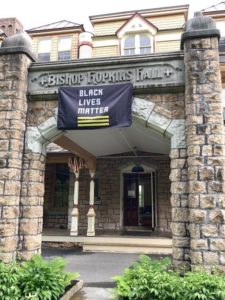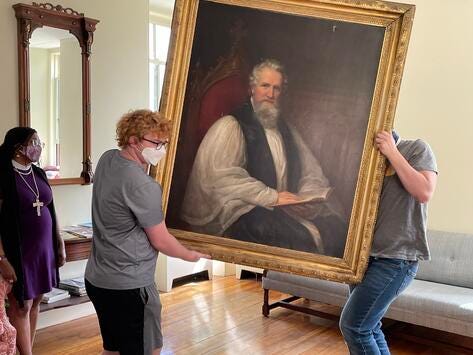I shall not oppose the prevalent idea that slavery is an evil in itself. A physical evil it may be, but this does not satisfy the judgment of its more zealous adversaries, since they contend that it is a moral evil— a positive sin to hold a human being in bondage, under any circumstances whatever, unless as a punishment inflicted on crimes, for the safety of the community. – The Rt. Rev. John Henry Hopkins, first bishop of Vermont
The students of Rock Point School in Burlington have removed a portrait of the Rt. Rev. John Henry Hopkins, first bishop of the Diocese of Vermont. Hopkins believed the controversy over slavery could be remedied by proving that it had a biblical basis. He is perhaps best known for his 1861 pamphlet, Bible View of Slavery. A second portrait of Hopkins remains on display with context written by the students.
The Rev. John Henry Hopkins Jr. built the school now used by Rock Point School in honor of his father.  The original school building continues to bear the name Bishop Hopkins Hall etched in stone. A Black Lives Matter flag now hangs alongside.
The original school building continues to bear the name Bishop Hopkins Hall etched in stone. A Black Lives Matter flag now hangs alongside.
The campus is located on Rock Point, a 146-acre parcel of land owned by the Episcopal Diocese of Vermont. The school was originally built in 1888 as Bishop Hopkins Hall, a finishing school for girls. It became the Rock Point School in 1928, and began admitting boys in 1972.
How the students came to their decision to move the portrait:
As we continued to have conversations about race and racism in classes and community meetings this year, we began to reflect on the school’s history and how it fits into the current national discourse on race. Through our discussions, we wondered how to reconcile the racist history of Bishop Hopkins, the role he played in the founding of the diocese, and his belief in the importance of educating women. Ultimately, the students decided that Bishop Hopkins’ portrait should be removed from the front hall because he does not represent our values.
The portrait was removed at an event attended by the Rt. Rev. Shannon MacVean-Brown, the first Black woman to head the Diocese of Vermont.
MacVean-Brown said she knows some will take issue with the painting being removed. People are complicated, she said, and while Hopkins did great things in his life, he also supported the enslavement of people — a practice that directly affected MacVean-Brown’s own family. Her grandmother’s grandfather was sold into slavery by his slaveowner father, she said.
“It’s important that we know that there was actually a person who said these things. A person in the same faith as me who, if we were contemporaries, would think that I was, you know, not quite as good or as human,” MacVean-Brown said.
“And so that’s why it’s important to not have to have that constant looming and honoring image present all the time in people’s faces,” she said. “And to put it into perspective.”

